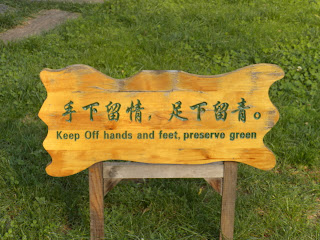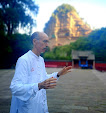Tung Shueh is one of the best overall formulas for joint and muscle pain - basically pain that in modern terms is described as arthritis or rheumatism. It is also good for acute and chronic injuries. The name "Tung Shueh (Pinyin: Tong Xue) means "circulate blood." The actions of the herbs found in the Tung Shueh formula are as follows...
Rhizoma Curcuma or Turmeric is an anti-inflammatory and is especially helpful for painful shoulders.
Rhizoma Homalomenae: The Chinese name is Qian Nian Jian
or "thousand years of health." It is an important herb for treating
joint pain that moves in the body or pain that is affected by changes in
the weather. Chinese herbalists say that it strengthens the tendons and
bones. It has a strong tonifying action and is also used for pain and
swelling due to traumatic injuries. In China it is widely used for
treating the elderly. It is traditionally combined with Achyranthis.
Fructus Chaemomelis Lagenariae
is one of the more effective herbs for relaxing the tendons. It is
beneficial for joint pain due to changes in weather and for pain in the
lower extremities.
Fructus Psoraleae is helpful for painful or weak lower back and extremities.
Plastrum Testudinis
or turtle shell strengthens the bones and is said to be good for
weakness of the lower back and knees. It is composed of calcium,
collagen (a protein found in connective tissue), lipids, amino acids,
and phosphorus.
Angelicae Sinensis
is one of the most researched herbs in Chinese medicine. It is
traditionally used as a blood tonic but another important action is
improving blood circulation and relieving pain. It is used for numbness
and pain in the extremities and painful joints. Modern research has
shown that it has analgesic and anti-inflammatory properties.
Cortex Cinnamomi
is said to disperse cold in the body and alleviate pain. It is used for
joint pain caused by wet and cold weather changes and back pain.
Frankicense
promotes the circulation of energy in the body. It alleviates pain and
is used for joint pain that moves in the body and pain that is affected
by damp weather. Commonly used with Myrrha for chronic pain (caused by
blood stagnation).
Myrrha circulates the blood and alleviates joint pain. It is commonly used with Frankincense for treating musculoskeletal pain.
Radix Aucklandiae is used to relieve stagnation.
Semen Benincasae
is useful for circulating fluids in the body. In Chinese medicine fluid
stagnation creates joint pain that feels heavy, distended or swollen.
Radix Morindae is useful for back, leg, and joint pain, as well as, muscle spasms and cramps.
Cortex Eucommiae is good for low back pain. it is also combined with Dipsaci for fractured or broken bones to promote the healing of bones.
Rhizoma Corydalis
is one of the most commonly used and the most effective herbs used to
relieve pain because it has an excellent ability to activate the Qi and
Blood circulation in the body. Corydalis can treat pain in the upper and
lower extremities and also be used for traumatic injuries. Research has
shown it has analgesic and anti-inflammatory properties.
Radix Dipsaci is known in Chinese as Xu Duan
or "restore what is broken." It is good for sore and painful lower back
and knees, stiffness in the joints and weakness in the legs. It is said
to promote the growth of bones when used for fractures.
Radix Achyranthis Bidentatae
is good for the tendons, bones, and joints. It is often used with
Eucommiae for pain and weakness of the lower back and extremities. It is
commonly used for sports injuries.
Flos Carthami (safflower) alleviates pain. It is used to disperse blood stagnation and open the channels.
Tung Shueh can beordered at http://www.eastearthtrade.com/tungshuehpills.aspx
Tuesday, January 1, 2013
Monday, December 24, 2012
Translating Chinese
A couple of years ago* I posted some comments about the need to have highly qualified people translating Chinese medical texts into English. Translation is difficult even for the most experienced.
Mo Yan, the 2012 Nobel Prize winner for literature recently addressed a reception at the Chinese Embassy in Stockholm on December 7 during his tour to the Swedish capital to receive his prize. He said "I think translation is much harder than writing: It only took me 42 days to write Life and Death Are Wearing Me Out, while it took Swedish sinologist Anna Gustafsson Chen six years to translate the work." (Source: Beijing Review, December 20, 2012).
* see: http://theriverlands.blogspot.com/2010/02/translating-acupuncture-texts.html
Mo Yan, the 2012 Nobel Prize winner for literature recently addressed a reception at the Chinese Embassy in Stockholm on December 7 during his tour to the Swedish capital to receive his prize. He said "I think translation is much harder than writing: It only took me 42 days to write Life and Death Are Wearing Me Out, while it took Swedish sinologist Anna Gustafsson Chen six years to translate the work." (Source: Beijing Review, December 20, 2012).
* see: http://theriverlands.blogspot.com/2010/02/translating-acupuncture-texts.html
Sunday, December 23, 2012
Chinese Idioms, English Idioms
I found a Chinese counterpart to the English saying "You can't teach an old dog new tricks" and I like it better.
It is: 活到老学到老 (huo2 dao4 lao3, xue2 dao4 lao3*) "One is never too old to learn".
It is much more positive and very true. We should continue to learn new things throughout our lives.
*The numbers after the words refer to tone marks
It is: 活到老学到老 (huo2 dao4 lao3, xue2 dao4 lao3*) "One is never too old to learn".
It is much more positive and very true. We should continue to learn new things throughout our lives.
*The numbers after the words refer to tone marks
Wednesday, December 19, 2012
Hsing-I Training
Hsing-I is considered one of the three internal martial arts in China. By chance, I was loaned a Chinese textbook on Hsing-I training that was used by someone who had studied Hsing-I in the early 1970's. The book was even more interesting because the instructor made handwritten notes along with the diagrams that shed more light on correctly performing each particular technique. I was able to scan diagrams and have posted below one of the pages.
Sunday, September 23, 2012
East Earth Travelogue: Shhh! "Grass is napping, please don't disturb"
If it were'nt for signs we would get ourselves into all kinds of trouble. Fortunately, the Chinese realize that most of us can't read Chinese and they have taken great efforts to accommodate us - sometimes with funny results. Here are some of the "Chinglish" signs I have found in China. (If you click on the pictures you can see them in an enlarged view).
This sign was posted on the front of a hotel in Baoding
Two signs from Xiang ge li la (Shangri-la) in Tibetan, Chinese and English.
Signs found around Lijiang
The sign below is from Lijiang. The top characters are in the Naxi Minority language, center is Chinese characters, and English below.
This was taken in the mountains around Jiuhua Shan. It has Chinese, English, and Korean. The picture says it all.
This sign was posted on the front of a hotel in Baoding
Two signs from Xiang ge li la (Shangri-la) in Tibetan, Chinese and English.
Signs found around Lijiang
The sign below is from Lijiang. The top characters are in the Naxi Minority language, center is Chinese characters, and English below.
This was taken in the mountains around Jiuhua Shan. It has Chinese, English, and Korean. The picture says it all.
Saturday, September 15, 2012
East Earth Travelogue: Unusual Menu Offerings
While visiting Lijiang we ate at a number of very good restaurants. One restaurant has some unusual items on the menu so I took a picture to share with you.
You can click on the picture to enlarge and read.
You can click on the picture to enlarge and read.
Monday, September 10, 2012
East Earth Travelogue: Delicious and Interesting Food
Traveling in China gives one the opportunity to try a lot of different food prepared in different ways. Here are some pictures of some of the dishes we had in Xiang Ge Li La and Lijiang. Picture 1: assorted vegetables. Picture 2: soup. Picture 3: I don't remember but it was good! Picture 4 is a rice dish prepared inside bamboo. You use your chopsticks to get the rice out. Picture 5 is a street vendor cooking a breakfast. Dough is rolled out like a pizza and placed on his stove, then he spreads an egg batter over it. After cooking for a few minutes and folding it in quarters you have a hot and delicious breakfast meal that will fill you up until lunchtime. Amazingly good and it's only about 50 cents! Picture 6 This dish is made from green peas. The peas are cooked until they become a thick paste and then they are fried. Picture 7 is a soup. You can see the Black Wood Ear Mushroom in the bowl. Very tasty! Picture 8 is a Naxi woman selling glutinous rice. They are just mildly sweet. The last picture is a bottle of Sour Yak's Milk. The plastic top is held on by a rubber band and you poke the straw through. It is very much like a liquid yogurt. Imagining drinking plain kefir but only better.
Subscribe to:
Posts (Atom)



























